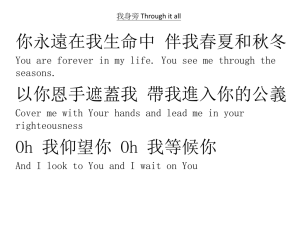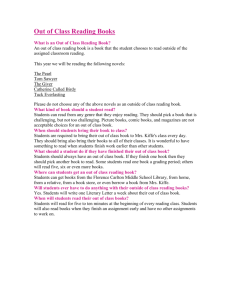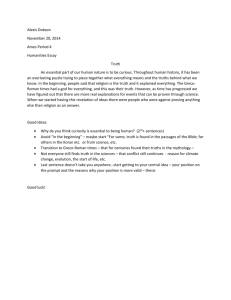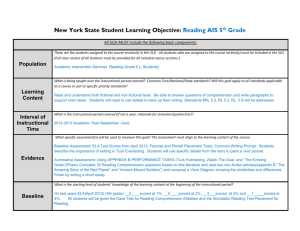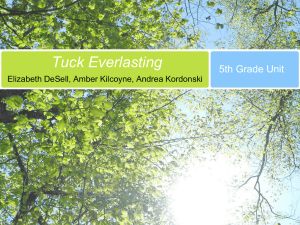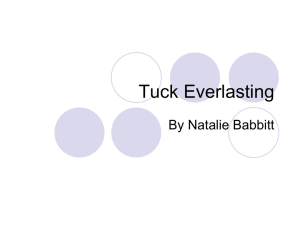Tuck Everlasting is - Dordt College Homepages
advertisement
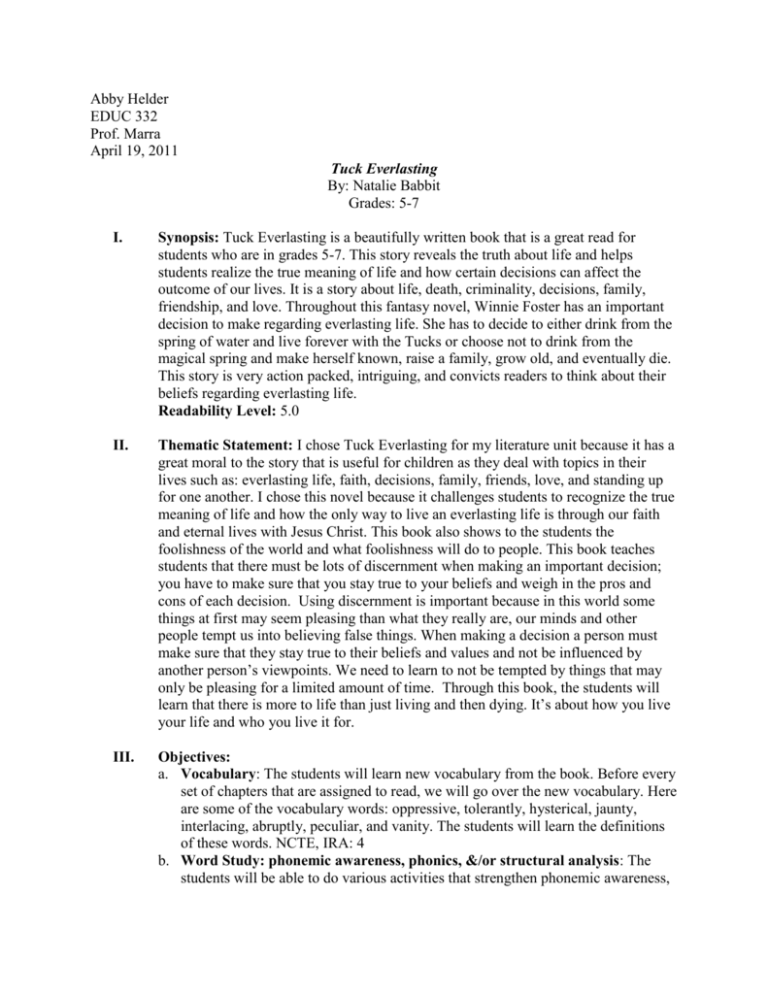
Abby Helder EDUC 332 Prof. Marra April 19, 2011 Tuck Everlasting By: Natalie Babbit Grades: 5-7 I. Synopsis: Tuck Everlasting is a beautifully written book that is a great read for students who are in grades 5-7. This story reveals the truth about life and helps students realize the true meaning of life and how certain decisions can affect the outcome of our lives. It is a story about life, death, criminality, decisions, family, friendship, and love. Throughout this fantasy novel, Winnie Foster has an important decision to make regarding everlasting life. She has to decide to either drink from the spring of water and live forever with the Tucks or choose not to drink from the magical spring and make herself known, raise a family, grow old, and eventually die. This story is very action packed, intriguing, and convicts readers to think about their beliefs regarding everlasting life. Readability Level: 5.0 II. Thematic Statement: I chose Tuck Everlasting for my literature unit because it has a great moral to the story that is useful for children as they deal with topics in their lives such as: everlasting life, faith, decisions, family, friends, love, and standing up for one another. I chose this novel because it challenges students to recognize the true meaning of life and how the only way to live an everlasting life is through our faith and eternal lives with Jesus Christ. This book also shows to the students the foolishness of the world and what foolishness will do to people. This book teaches students that there must be lots of discernment when making an important decision; you have to make sure that you stay true to your beliefs and weigh in the pros and cons of each decision. Using discernment is important because in this world some things at first may seem pleasing than what they really are, our minds and other people tempt us into believing false things. When making a decision a person must make sure that they stay true to their beliefs and values and not be influenced by another person’s viewpoints. We need to learn to not be tempted by things that may only be pleasing for a limited amount of time. Through this book, the students will learn that there is more to life than just living and then dying. It’s about how you live your life and who you live it for. III. Objectives: a. Vocabulary: The students will learn new vocabulary from the book. Before every set of chapters that are assigned to read, we will go over the new vocabulary. Here are some of the vocabulary words: oppressive, tolerantly, hysterical, jaunty, interlacing, abruptly, peculiar, and vanity. The students will learn the definitions of these words. NCTE, IRA: 4 b. Word Study: phonemic awareness, phonics, &/or structural analysis: The students will be able to do various activities that strengthen phonemic awareness, c. d. e. f. g. h. IV. phonics, and structural analysis. They will be able to use the vocabulary words to do the activities. They will understand the sentence structure in the book. NCTE, IRA: 3 Comprehension: The student will be able to practice comprehension and knowledge of the text that they read in each chapter. There will be discussion and comprehension questions during the reading to keep the kids on task. There will also be worksheets that will encourage comprehension. NCTE, IRA: 3 Fluency: The students will gain reading fluency through various fluency strategies. The students will practice reader’s theatre by acting out a specific part of the book. While reading, the students will also practice: supported oral reading, partner reading, repeated reading of grade level, and choral reading. NCTE, IRA: 4 Writing: The students will be able to write their responses of Tuck Everlasting in their journals and be able to write responses that include their Christian perspective. They will also share their thoughts with other writers in the classroom. The students will also be able to practice their writing through various writing activities. NCTE, IRA: 4, 5 Drama/Genre or author/illustrator: The students will know that Tuck Everlasting is a fantasy novel. They will understand what fantasy means and will be able to do activities that involve the genre. The students will also learn about the author, Natalie Babbit. NCTE, IRA:2,6 Effective Use of Technology: The students will watch the movie Tuck Everlasting and will then be able to compare and contrast the movie with the book. NCTE, IRA: 8 Christian Perspective: The students will be able to tie in a biblical perspective into the reading, writing, and discussing that they do as they read Tuck Everlasting. They will know the importance and value of life and that the only way you can have everlasting life is through Jesus Christ. This book will help students have a better understanding of themselves, their faith, and their beliefs. NCTE, IRA:1 Pre-reading Activities: a. Assess and increase background knowledge: To assess and increase the background knowledge the students have of Tuck Everlasting, I am going to have them write in their reading journals about the question I ask them regarding the genre of the book. Here is the question that I will have them answer: 1. What is a fantasy novel and how do you know when a book is fantasy, what are some hints? After the students write their answers down in their journals, I will have them discuss their answers together as a whole class. I will then tell the class that we are going to be reading a fantasy novel called, Tuck Everlasting. I will have the students read the back of the book and then have them answer this question in their journals: 2. Why do you think that Tuck Everlasting is a fantasy novel? What are some hints from the back of the book? V. I will then have the students read along as I read the prologue to them. After I have finished reading the prologue, I will have the students make predictions of what they think is going to happen in the story. Here is the question I will have them journal about. 3. Make a prediction about how you think those three things listed on page 4 of the book connect to each other. 1. Mae Tuck set out on her horse to meet up with her sons in Treegap. 2. Winnie Foster decided to think about running away. 3. A strange man appeared at the gate and was looking for someone. I will then have the students share their predictions with the class of how they think that these three things are connected during the story of Tuck Everlasting. b. Introduce key concepts and vocabulary: I will go over key vocabulary from the book with the class. I will hand out a vocabulary worksheet and have them write down the definition for each word on the worksheet. I will let them work in partners and let them use resources to find the definition of the words. The students will each get a vocabulary word assigned to them and have to look up the definition and then act out the word, draw it out, or do something that conveys the meaning of the word to their fellow classmates. I will then have the class brainstorm their thoughts of what everlasting means. I will write their ideas on a big piece of paper and put it up in front of the classroom. I will tell the class what everlasting is and then I will tell the class that this book refers to everlasting life. c. Introduce the story in a manner to stimulate interest: To introduce the story in a manner to stimulate my students’ interest, I am going to do a type of drama/ commercial. I will get out a jar of water and act like a salesperson trying to sell them water that will give them everlasting life. I will make the everlasting water sound wonderful. I will tell the kids that if they drank the water they would live forever and get to see more of the world and get to do more things. I will tell them that it’s their decision whether or not they decided to take a drink of the water that gives them everlasting life. Lastly, I will tell them that I will give it to them for free. I will go up to each person and ask them whether or not they would take the sip of water. For the students who decided to take the sip of water I will ask them why they chose to drink the water. For the students who said no to the water I will ask them why they chose not to drink the water. I will tell the students that throughout this book they will see the pros and cons of drinking from the everlasting life and in the end they will find out if Winnie decides to drink from the spring and grow old with the Tucks forever. Reading: a. Explain how the story will be read keeping in mind less able readers and ELLs: I will use a variety of methods to read as we read Tuck Everlasting. This way all of my students needs will be met including less able readers and ELLs. This also will make reading more exciting and keep the students interested in the book and help increase their vocabulary knowledge, fluency, and levels of comprehension. Each section of reading that will be assigned will be about 3-4 chapters long. Each section will be read with a different reading strategy so that the students learn how to read in different ways and become stronger readers. As the teacher, I will read the first and last few chapters of Tuck Everlasting with the class. This way I can get them on track with the book and start the first discussions with them. The teacher should also read the last few chapters with the class so that they can guide discussion of the conclusion of the book together. As the teacher I will also start out each reading section by reading out loud the first few pages of the assigned reading to the class then send them off to do the various reading strategies. For Reading Tuck Everlasting, I will be using the five reading strategies from Tompkins book: Literacy for the 21st century (pg. 44). These strategies include: Independent reading, Buddy reading, Guided reading, shared reading, and reading aloud to students. 1. Independent reading: During independent reading time I will let the students spread around the room to make sure that they are comfortable. This will allow them to read at their own pace. If they have any questions they are encouraged to come and ask me. During this time, I will also use this time to work one on one with the readers in my class who are struggling and for the ELL readers as well. 2. Buddy reading: During Buddy reading time I will pair up the students according to their reading levels. I will have them each take turns reading out loud to each other. This will help them feel comfortable with reading to another person. During this time they will be able to work on their comprehension by asking each other questions and discussing their thoughts about what they are reading. I would encourage that after every page they discuss what they have read. 3. Guided Reading: During guided reading I will read for the first little bit, and then I will let my students read using their own strategy. I will observe each student to see what reading strategy they are using. 4. Shared Reading: During shared reading, everyone will have the opportunity to read out loud to the class. Some students may not feel comfortable reading in front of others so I will make sure that this type of reading is just for volunteers who feel comfortable to read. 5. Reading Aloud to Students: VI. I will read the beginning of each assigned section of reading so that I can recap what the previous chapters were about and help them begin and dig into the next chapter. Responding: a. Explain what you will do to keep students accountable for their reading: To keep my students accountable for their reading I will have a reading checklist for them. This will help them know what chapters need to be read and also what activity and journal entry is due that day. I will have the student journal after every assigned section of reading. These journal entries will help the students keep track of their reading, help them comprehend what they read, and let them write down their feelings and opinions of the topics being expressed in the book. An example journal entry would be: Winnie had to make a big decision of whether or not to take a drink of the water. Have you ever had to make an important decision? How so? b. Include a set of questions based on literary elements for one chapter: Since the chapters are short I will be going over the literary elements for chapters six and seven. 1. Chapter six and Seven and Eight: Setting i. Where did Winnie meet Jesse, Miles, and Mae? ii. What is the name of the woods? iii. Where do the Tucks take Winnie? Character i. Who are the characters in these two chapters? ii. What does Winnie learn that is special/ strange about the Tucks? iii. Do you think that the Tucks are criminals for kidnapping Winnie? iv. What do you think the man in the yellow suit is going to do with the information about the Tucks and the spring? Plot i. What is the story of the Tucks? How come they will never grow old and die? ii. Why do you think that it would be bad if everyone knew about the spring of water that gave everlasting life? KWL Chart i. Have the class fill out a KWL chart. Have them base the chart of the 8 chapters that they have read already in the book. c. Explain how the novel will be discussed: Discussion is going to be a very important role in this unit on Tuck Everlasting. The ideas and themes of this unit are very deep; discussion will help create a greater understanding of the topics VII. and themes presented in this book. The story will be discussed in several different ways: 1. When the students are reading the book silently, the students will be encouraged to write down questions that they have about a certain topic that was brought up in the assigned reading that they had. The students will then be able to ask these questions in front of class so that the teacher can give them a better understanding of the topic they are confused about. 2. When the students are paired up to read with partners I will give them thought provoking questions about the assigned reading and have them discuss with each other what they think and how they would answer that question. This way they can collaborate with each other their ideas, their values, what they think is going to happen in the book, and their beliefs regarding everlasting life. 3. When the teacher reads out loud to the class, there will be comprehension questions after each couple of pages. This will start discussion amongst the whole classroom about the book. 4. After every assigned section of the book, I will group the students and hand them a discussion question. They will have to discuss the question with their group then lead the discussion up in front of the whole class. 5. One of the main topics of discussion that will be assigned in each of these discussion strategies is the topic of everlasting life. I want the students to be able to share their beliefs of everlasting life and be able to realize the difference between the everlasting life from the water and everlasting life from Jesus Christ. 6. During all of the discussion, I will make sure that there is a Christian perspective and that students will learn to value the importance of life and the true meaning of everlasting life in Jesus Christ. Exploring: a. Explain how new vocabulary will be taught/reviewed: Before every new section of reading, we will go over new vocabulary words and also review the vocabulary from the previous chapters. I will give the students a list of the vocabulary words for each chapter. They will then be assigned each to a word and look up the definition of the word and write it down. I will also have the students write the word and definition on an index card so that they can look back on the vocabulary. Another activity that I will have the students do is hand out vocabulary words to each of the student and have them look up the definition of the word, and then I will have them find the word in the assigned reading section and then have the students draw the scene where the vocabulary word was used. I will use other various activities to learn new words such as: Charades, word walls, and matching. b. Explain how you will give the students opportunities to develop fluency: I will give my students various activities where they will be able to develop fluency. I will assign important scenes from the book to groups of students and have them do a readers’ theatre activity of acting out the scene that was assigned to them. The students will also develop their fluency by reading the book silently to themselves, with a partner, out-loud with the whole class, through choral reading, and through following along in the book while the teacher reads to them out-loud. I will also have the students pick their favorite passage from the book and practice their fluency by reading part of the passage to the class, explaining what the passage means, and their reaction to the passage that they chose. c. Explain briefly the steps for a word study mini lesson-phonics or structural analysis: First, I will explain to the students that the author of the book, Natalie Babbit, uses a lot of figurative language in her writing. I will tell the class what figurative language is. I will then explain to the class that Natalie Babbit uses similes and metaphors in her writing. I will tell the class what a metaphor is and what a simile is. A metaphor: is a comparison. A simile: Compares one object or idea to another, using words like or as. I will have a worksheet for the students that deals with metaphors and similes that are in the story. They will have to match them and tell why the phrases I gave them were a metaphor or a simile. I will also have them make their own sentences with similes and metaphors in them. d. Include activities to increase comprehension: There will be lots of discussion of the book that will help students gain understanding and comprehension. I will have the class journal their thoughts about what they read. After every set of chapters, there will be comprehension questions that will engage the reader and help them develop their understanding and comprehension of the book, and will be able to help them voice their opinions and beliefs to the class. Here are some of the in depth comprehension questions that will be asked after every section of reading: 1. What was that music? Where do you think it’s coming from? Who do you think is playing it? 2. How do you feel about the man in the yellow suit? 3. Why would it be a disaster if people found out about the water? 4. “Well, boys, she said, “here it is. The worst is happening at last.” What do you think Mae means by this? 5. How is this everlasting life different from the everlasting life of salvation? 6. Do you think the water from the spring was created for good before the fall came and sin distorted it? 7. Winnie has to make an important decision, what is this decision? Have you ever had to make an important decision...if so, what was it? e. Include some writing, drama, and genre or author/illustrator study: 1. Writing: The students writing project will be to finish their journals and then have them write a final journal entry about whether or not they would take a drink from the spring? Why? Have them respond to this question: How do you see faith incorporated in this book? Have the students do a compare/contrast worksheet about the difference between the everlasting life from the spring and the everlasting life from Jesus Christ. 2. Drama: After the book is finished I will have the class act out their favorite scenes from the book. Here are some scenes that they can choose from: 1. Winnie meeting Jesse for the first time. 2. Winnie meeting the Tucks. 3. Winnie and Mr. Tuck on the lake 4. When Mae hit the man in the yellow suit with her gun. 5. Mae and Winnie switching places in the jail. 3. Author/illustrator: The students will do some research on Natalie Babbit. They will fill out a worksheet about Natalie Babbit. VIII. Applying: a. Include how children will share projects and assignments: 1. Journals: the students will share parts of their journal with their classmates and use them for class discussions. At the end of the unit, the journals will be handed in to me for assessment. 2. For the worksheets: they will just be turned in to the teacher for credit. 3. Drama: The students will act out a scene of the book in front of the class. 4. Fluency: The students will read their favorite passages from the book to the class. IX. X. 5. Vocabulary: Students will work together to find the meaning of the words. 6. The final project is writing about how their predictions matched up to the end of the book. The students will have to share their results to the class. b. Explain what other activities will be continued after the unit is complete: After the unit is complete, I will still have the class journal. This is a great way to encourage them to think about what they have read and be able to apply it to their everyday lives. It also increases fluency and comprehension. I will also have all of the related books to Tuck Everlasting available so that students can keep reading books that are similar and in the same genre. Assessment-Match assessment to objectives: a. List the informal means of assessment-these should be explained in other parts of the unit. 1. Vocabulary Activities (Objective A) 2. Metaphor and simile worksheet ( Objective B) 3. Author Study (Objective F) 4. Journals (Objective E) 5. Compare/contrast chart (Objective H, E) 6. Movie Review (Objective G) 7. KWL chart (Objective E, C) 8. Discussions/participation (Objective H, D, C) 9. Observation of reading (Objective H, C) b. Formal( See appendix A) Classroom Management Plan: a. Tell how assignments will be managed. See checklist (Appendix B): In order to keep all of the students’ assignments well managed I will hand out an assignment checklist to all of the students (See Appendix B). I will also give each student a journal where they will write all of their journal entries in. I will also give them a folder where the students will put all of their notes, worksheets, vocabulary sheets, and other assignments in. This will help the students stay organized. All of the assignments will be collected after the lesson is over. Once the students have turned in the assignment they will check off the assignment in their checklist. This way if an assignment is missing they can look back at their checklist to see which assignment they neglected to do. When a student is organized they will have a better chance of succeeding in the classroom. b. Tell how the needs of ELLs and below grade level readers will be accommodated: To help Ells and below grade level readers the teacher will work one on one with these students to ensure, knowledge of vocabulary, comprehension, and fluency. During silent reading time, I will have these students XI. read with me and I will help guide them along. When there is partner reading, I will partner the student up with a very high level reader so that they can help the ELLs and the below grade level readers read effectively and confidently. For ELL readers I will do lots of vocabulary work so that the students can really learn the vocabulary and be confident in it. I will also provide a tape of the reading so that both ELLs and lower grade level readers can follow along in the book while they listen to the recording. I will also provide many different reading strategies for these types of readers so that they learn how to read in multiple ways using different strategies that will give them better comprehension and fluency. I will make sure that these students take their time and read to their level, I want these students to feel comfortable reading with the class and not feel embarrassed because of the level of reading that they are at. c. Explain a general plan for keeping the class orderly and what students will do when they are finished with their regular assignments: I want this unit to be fun, but I also want to keep it orderly. I will remind my students to be respectable of their classmates while they are reading out loud, silently, or while we are discussing the book as a whole class. I want the reading environment to be relaxed, quiet, and an atmosphere that is comfortable for all levels of readers to share their thoughts, and to be able to read out loud. I will remind the students to behave well and also will remind them of their task that they are supposed to be doing. When the students are finished with their in class assignments, I will have them do a little of their own reading. I will let them read some of the related books. This will also be a good time for them to finish any other homework assignments and to get started on the next assigned reading. Bibliography: a. List books at several different reading levels that are related to the unit: 1. Abbot, T. (2010). The genie king. Illus. by. Royce Fitzgerald. Scholastic Book Service, 168 pages. (R:4.2) 2. Dorris, M. (1996). Sees behind trees. Hyperion, 104 pages. (R:5.2) 3. Hesse, K. (1996). Music of dolphins. Scholastic Book Service, 181 pages. (R: 3.4) 4. Lasky, K. (2007). Guide book to the great tree. Illus. by. Richard Cowdrey. Scholastic Book Service, 167 pages. (R: 6.5) 5. Osborne, M. (2009). Moonlight on the magic flute. Illus. by. Sal Murdocca. Random House, 106 pages. (R: 3.7) 6. Woodruff, E. (1994). Magnificent mummy maker. Scholastic Book Service, 132 pages. (R:4.9) b. List the sources you used to teach the unit: 1. (2003). Tuck Everlasting [Motion picture]. Major Video Concepts. 2. Babbit, N (1997).Scholastic literature guide: Tuck everlasting. Scholastic, 16 pages. 3. Babbit, N. (1975). Tuck everlasting. Square fish, 148 pages. (R:5.0) 4. Urbschat, K. (1991). Tuck everlasting. Perfection Form Company, 55 pages. Appendixes A. Test or Quiz: Unit Test: Tuck Everlasting Name: I. 1) 2) 3) 4) 5) 6) Vocabulary: Write down the definitions to these words. Tangent:_______________________________________________________________ Rueful:_________________________________________________________________ Hysterical:______________________________________________________________ Marrionette:____________________________________________________________ Abruptly:_______________________________________________________________ Suspected:______________________________________________________________ II. Metaphor/ Similes: Write a metaphor from the book and also write a simile from the book. 1. Metaphor:____________________________________________ ______________________________________________________ ______________________________________________________ 2. Simile:________________________________________________ ______________________________________________________ ______________________________________________________ Writing: 1. Why was it so important for Winnie to keep the everlasting water a secret?________________________________________________ ______________________________________________________ ______________________________________________________ ______________________________________________________ ______________________________________________________ ______________________________________________________ ______________________________________________________ ______________________________________________________ III. IV. Author/Genre: 1. What is the genre of this book? ___________________________ 2. Who is the author of Tuck Everlasting? ____________________ 3. Write two facts about the author: a. ________________________________________________ ________________________________________________ b. ________________________________________________ ________________________________________________ Fluency: Write about your favorite scene from the book. _____________________________________________________________________ _____________________________________________________________________ _____________________________________________________________________ _____________________________________________________________________ _____________________________________________________________________ _____________________________________________________________________ Christian perspective: How does a Christian’s view of everlasting life compare to the everlasting life displayed in the book? _____________________________________________________________________ _____________________________________________________________________ _____________________________________________________________________ _____________________________________________________________________ _____________________________________________________________________ _____________________________________________________________________ _____________________________________________________________________ _____________________________________________________________________ V. VI. B. Assignment Checklist: Name: Assignment Checklist Reading Assignments: Assignment Day 1:Prologue Day 2: Chapters 1-4 Day 3: Chapters 5-8 Day 4: Chapters 9-11 Day 5: Chapters 12-14 Completed Assignment Day 6: Chapters 15-17 Day 7: Chapters 18-20 Day 8: Chapters 21-23 Day 9: Chapters 24-25 Day 10:Epilogue Completed Journal Assignments: Assignment Question Completed Day 1: Prologue Make a prediction about how you think those three things listed on page 4 of the book connect to each other. Day 2: Chapters 1-4 Why would it be a disaster if people found out about the water? How would you feel if you were kidnapped? What would comfort you? Why do you think it was so good for Tuck to see Winnie? Respond to this line: “Life’s to enjoy yourself, what else is it good for?” As Christians, why do we disagree with this statement? Why are we placed here on this earth? Day 3: Chapters 5-8 Day 4: Chapters 9-11 Day 5: Chapters 12-14 Day 6: Chapters 15-17 “People got to do something useful if they are taking up space in the world”. How does this reflect our Christian duty? Day 7: Chapters 18-20 Do you think that Mae Tuck is a villain for hitting the man wearing the yellow suit in the head? Pretend to be Winnie and write a response about how you feel trading spaces with Mae in the jail. Write your prediction of whether or not Winnie drank the water. Write a response to the ending of this book and write how you saw a Christian perspective in the book. Day 8: Chapters 21-23 Day 9: Chapters 24-25 Day 10: Epilogue Daily Assignments/Projects/Homework: Day: 1 2 3 4 5 Assignment: Author study Just read and journal KWL Chart Just read and journal 6 7 8 Just read and journal Just read and journal Compare/ Contrast chart Metaphor and simile worksheet Completed: 9 10 Movie Review Final journal entry and finished journal C. Language Arts/Reading standards from another state for the grade level you selected: Standards from NCTE, IRA: See Standard Handout
